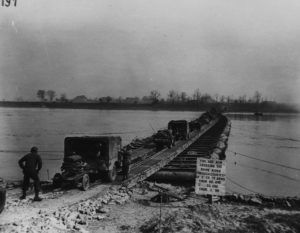 |
| USACE Logo |
On March 16, 1802, President Thomas Jefferson authorized the establishment of a military corps of engineers, which became the U. S. Army Corps of Engineers we know today. This was the second time that this corps was established.
The first idea for the army to have organized engineers took place on June 16, 1775, when the Continental Congress officially organized the army specifying that it contain a chief engineer to oversee the construction of fortifications and defenses and other such military tasks. This date might be considered the Corps’ inception.
Col. Richard Gridley, a Boston native, became Gen. George Washington’s first chief engineer. Gridley was an experienced military engineer who had done such work during the French and Indian Wars, from the capture of Louisburg (1745) to the fall of Quebec (1759). If that 1775 date seems familiar, that is because Gridley’s first mission as chief engineer was to lay out the defenses for the fortifications on Breed’s Hill where the unruly colonial rebels defied British might in the next day’s Battle of Bunker Hill.
In March of 1779, the Continental Congress authorized then Chief Engineer Brig. Gen. Louis Duportail to separate the engineers from the army at large into a corps of their own. This was the first time. By this time, Congress had recruited quite a number of military engineers from France, who were supplemented by three companies of sappers and miners formed from American troops in 1778.
 |
| US 9th Army crossing Rhine River on USACE pontoon bridge, 1945 |
The Corps of Engineers was mustered out of service at the end of the Revolution, along with most of the rest of the army. A flutter of war murmurings in 1794 resulted in a short-lived Corps of Artillerists and Engineers for the development of seacoast fortifications. A single regiment of engineers remained in active duty through peacetime.
Support for the 1802 legislation that ultimately established the Corps came from many directions. During the American Revolution, officers and statesmen both recognized the need for officers skilled in technical, scientific, and mathematical trades. During the war, some effort was made to train the companies of sappers and miners in field works, but it was woefully insufficient, prompting wide support for a formal academy where officers could train for such work. The 1802 legislation called not only for the permanent establishment of a corps of engineers, but also for the creation of an academy where soldiers could have formal education in the skills and techniques required in engineering. West Point was chosen as that academy. Jefferson was a staunch promoter of this whole project, anticipating that such soldiers would be valuable in service to the nation during peacetime as well as during war.
As a result, today’s U. S. Army Corps of Engineers is engaged in and coordinates with both foreign and domestic war efforts, homeland security and disaster preparedness, infrastructure support (bridges, dams, and other civil and military installations), water resource management of flood zones and navigable waterways, and environmental restoration and stewardship. It is the world’s largest public engineering, design and construction management agency.
 |
| Erection of Civil War signal tower, Fort Pocahontas, James River, VA |
The Corps, over the past 210 years, has included and excluded various other duties, as branches have developed, diminished, or merged with other services. Among these was a Corps of Topographical Engineers which branched off in 1838, but reunited with the USACE in 1863. During the 19th Century, the USACE coordinated with the Navy to manage the Lighthouse Districts. (My great-grandfather and some of his brothers and nephews served in the Lighthouse Service in Maine.) Lighthouses are now managed by the U. S. Coast Guard. And in the first half of the 19th Century, Congress established a survey service for the Great Lakes (the Lake Survey), which fell under the umbrella of the Corps of Engineers.
In my Civil War reenacting portrayal of a military engineer, I have the opportunity to teach school children about this part of the army, which was quite small during the Civil War. My nutshell emphasis to them is that although the job of the rest of the army was to destroy things, the job of the engineers was to build things. I find it fascinating myself at the 19th Century application of mathematics and physics to solve problems in the field, under conditions usually remote from the ideal and often with limited resources. These solutions were often very simple, and often ingenious. This corps deserves more recognition than it gets.
SOURCES:
U. S. Army Corps of Engineers http://www.usace.army.mil/About/History/HistoricalVignettes/HolidaysObservances/015EstablishmentofUSACE.aspx
Wikipedia: US Army Corps of Engineers http://en.wikipedia.org/wiki/United_States_Army_Corps_of_Engineers
PHOTOS:
Logo: U.S. Army Corps of Engineers http://www.nau.usace.army.mil/
Pontoon bridge: U.S. Army Corp of Engineers Digital Visual Library http://images.usace.army.mil/Main.html
Signal tower: at Fort Pocahontas on the James River, Charles City County, VA, May 2002, by Sally M. Chetwynd



